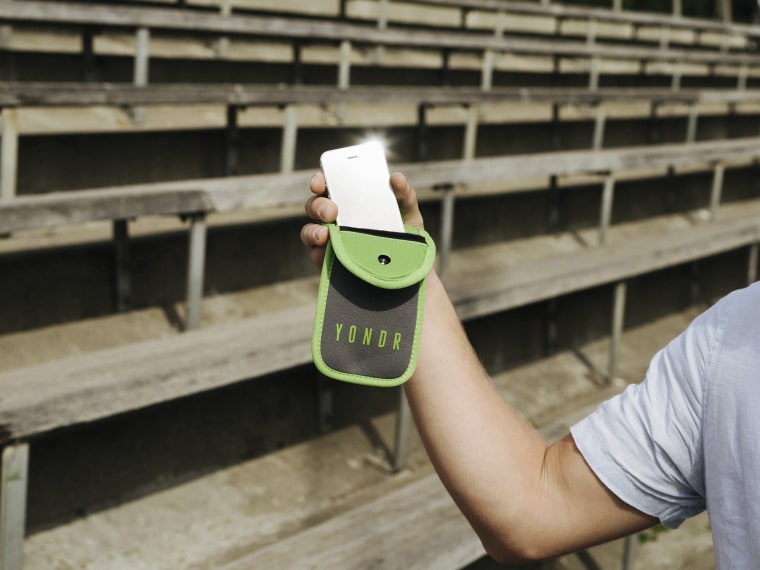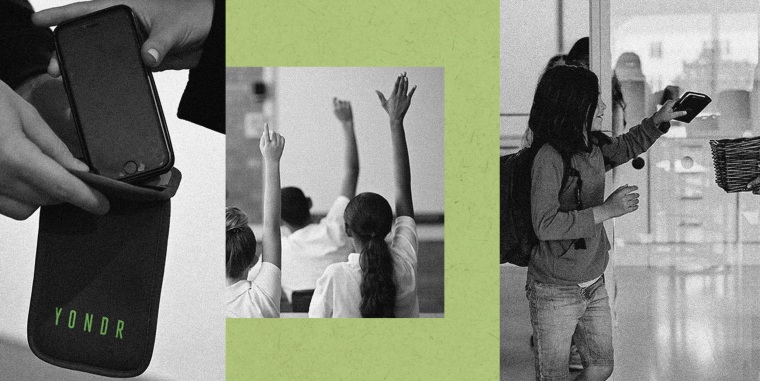A surprisingly simple system to prevent kids from accessing their phones during class is gaining traction at schools across the U.S., and bringing in millions of dollars for a California startup called Yondr.
Yondr produces magnetically sealed fabric pouches to lock up phones or other devices.
The pouches, colored gray and green, are reusable and only slightly bigger than a smartphone. They lock and unlock with the touch of a specialized magnet, making them harder to open than a fabric fastener, and they’ve become ubiquitous in a growing number of schools nationwide.
In the past eight years, school districts in 41 states have spent $2.5 million to buy pouches from Yondr, according to Govspend, a database of government contracts and purchases. Most of the spending has occurred since May 2022, according to Govspend, as concern has grown over phones in schools and the effects of smartphone use on children.
Graham Dugoni, the CEO of Yondr, invented the pouches in 2014 when there was less anxiety about the amount of time kids spent on phones.
“At the time, I was going around door-to-door. I had 500 pouches in the back of my car, and I’d go around to schools during the day and concert venues at night,” he said in a phone interview.
Originally, Yondr made headlines for how the pouches were used at music venues by artists who felt that phone use took away from their live performances.
Among Yondr’s earliest and loudest boosters have been entertainers who want phone-free shows such as comedians Dave Chappelle and Chris Rock and musician Jack White.
When Dugoni spoke with schools, “the answer generally was, ‘We’re trying to get more technology into schools, not less,’ and that has really flipped,” he said.
Concern over kids’ screen time is increasingly spilling into the halls of Congress and courthouses. Last month, two senators proposed legislation to study the effects of cellphone use in K-12 classrooms, and dozens of school districts are suing the parent companies of Facebook, TikTok, Snapchat and YouTube over what they say are the costs associated with app use.
About 46% of teens say they are online “almost constantly,” roughly double the share who said the same thing in 2014-2015, according to surveys over time by the Pew Research Center. In a Pew survey this year, 95% of teens ages 13 to 17 said they had access to a smartphone.
And for some, the pings from their phones are constant. About half of kids ages 11 to 17 get at least 237 notifications on their phones in a typical day, and of those notifications, 25% arrive during the school day, according to a report this year from Common Sense Media, a group that studies the impact of media and technology.
Diego Ochoa, the superintendent of the San Mateo-Foster City School District in California, said his district finally had enough in spring 2022.
“Teenagers were taking videos of each other on their phones. These were videos of kids in locker rooms. These were videos of kids bullying each other,” he said. “The phones represent this Wild, Wild West.”
Ochoa said a neighboring district was trying out Yondr pouches, and his district heard about it through word of mouth. They held meetings with parents to introduce the idea and reduce some of their anxiety about being out of touch with their kids, and then they began requiring the pouches at all four of the district’s middle schools simultaneously. (Local high schools there are under a different administration.)
“The system is deceptively simple,” Ochoa said. “Every kid goes home with their pouch and comes back with their pouch.”

In the San Mateo-Foster City district, as at many other schools and music venues, the locking mechanism is kept near the school’s entryway, allowing students to tap their pouches on the way in — and keep their phones on them even as the phones are locked up.
There has been a learning curve. Parents and guardians now call the school’s office to reach a student if there’s a family emergency, and some students asked for and received exceptions, such as diabetic students who use a glucose-monitoring smartphone app.
But Ochoa called the pouches “an unquestioned success.” Students are paying more attention in class and spending more time talking with each other outside class.
Smartphone bans in schools, though, have their skeptics. Anthony Vaccaro, a postdoctoral research associate at the University of Southern California who studies brain science, said schools may want to look for other causes of distraction and bullying, rather than blaming phones entirely.
“Just because we removed the phone from the environment doesn’t mean these issues are going to go away,” he said.
And he said it’s important for kids to learn how to self-regulate their phone use before they’re adults — something that he said might be more difficult to learn with zero access to a phone. Using a pouch like Yondr’s could help if it’s for only part of a day, he said.
Some students have also registered their skepticism. On the petition-making website Change.org, there are about 80 petitions about Yondr, many of them from students seeking to stop the pouches or scale back their use. Some petitions say phones are invaluable during a school shooting or even to document bullying. And online message boards and videos suggest ways to get around the Yondr system, although school administrators say it’s usually pretty obvious when it happens.
Dugoni, the Yondr CEO, said that in his experience, students eventually see some benefits.
“I definitely appreciate their gusto,” he said of the petitions, “but also a lot of them, when they step into the experience and it becomes a habit, they start to appreciate it.”
Francine Avila, the principal of East Los Angeles Renaissance Academy, a high school, said a major attraction of Yondr for her school was that students get to keep their locked-up phones with them rather than surrendering the phones to a central storage area.
“Still having the phone on them helps to lower the anxiety,” she said.
“It’s a part of their body almost, and if you take it from them, you take the social-emotional component that goes with it,” she said.
East Los Angeles Renaissance Academy is among Yondr’s most recent customers, having just implemented the pouches after Thanksgiving. A few weeks in, Avila said students were getting to class on time more often and speaking more in class. She said there could be changes to the program eventually — such as allowing students with high grades phone time during lunch, as an incentive — but she said the pouches are one way to allow a school’s culture to catch up to technological change.
One small unexpected challenge, she said: Students didn’t know what to do during lunchtime, so school staff offered more activities and sports during lunch.
“All of a sudden, there’s a line to play ping-pong,” she said.
